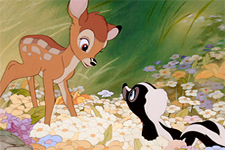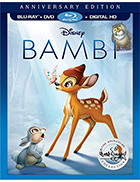Bambi
|  In From Walt to Woodstock: How Disney Created the Counterculture, author Douglas Brode offers up a compelling and completely original take on the classic works of Walt Disney, arguing that, rather than contributing primarily to the commoditization and conglomeration of culture, Disney’s most profound legacy was shaping the ideologies of the Baby Boomers born in the 1940s into the counterculture of the 1960s. Although frequently viewed now as naïve or (worse) reactionary, many of Disney’s animated films are actually rife with the kinds of ideas that would fuel the Age of Aquarius—everything from the beauties of multiculturalism, to the crucial importance of individuality. And there is probably no better example than Bambi, Disney’s fifth animated feature. Released during the summer of 1942, just after the United States had entered World War II and Disney had turned almost exclusively to war-time filmmaking (it was the only studio to be designated as a war production plant by the government), Bambi is the animated film as pastoral poem, as beautiful a depiction of the natural world as one could imagine. Bear in mind, of course, that Bambi is not necessarily an accurate depiction of nature, but rather a carefully inscribed portrait of nature idealized—largely free of conflict, violence, and brutality, except when, in the film’s jarring turn of phrase, “Man has entered the forest.” In terms of shaping the counterculture of the 1960s, there is no prewar film that more succinctly capitalizes on the perceived divide between humankind and nature, with the latter portrayed as an unspoiled, Eden-like paradise and the former as a threatening, unseen, but always felt force of destruction. There was much discussion amongst the film’s story artists and screenwriters regarding how the human characters would be portrayed, and their ultimate decision to keep them entirely off screen was a brilliant choice. Much like the shark in Spielberg’s Jaws (1975), the hunters who enter the forest are more effective as an unseen presence, lurking just outside the film’s frame, yet profoundly affecting everything within it. By remaining unseen, they become abstract—not individual characters, but rather a roving, haunting symbol of humankind’s darker impulses, which makes their hand in killing Bambi’s mother (another off-screen event whose emotional impact left an entire generation of children in shock) all the more distressing. In this regard, it is tempting to see Bambi as profoundly anti-human, as it seems to suggest that there is no sense of decency in the human race: We kill and burn, and that is all. Yet, to see the film in such a light is to misunderstand the manner in which it borrows the best of human nature and anthropomorphically inscribes it in the animal characters. That is why it was so crucial that the animators find new means of depicting animal movement and behavior that is completely natural and realistic (Walt had a virtual zoo installed at the studio so his artists could observe the animals they would be drawing), but also endowed with recognizable human qualities. It is that mixture of the human and the animal that makes Bambi so memorable and so historically meaningful. Animators had certainly presented anthropomorphized animals on screen before (just the previous year Disney had given us Jiminy Cricket, a grasshopper playing the role of the human conscience, in Pinocchio), but never before had they endeavored to so fully merge human and animal characteristics, such that the animals remain true to their nature, yet are also somehow us. The titular fawn in Bambi, who begins as an awkward newborn (voiced by Donnie Dunagan and Hardie Albrigh) and eventually grows up to be a strong buck (voiced by John Sutherland), is an idealized vision of human development, nurtured by both a caring mother (Paula Winslowe) and a community of critters who work together despite the fact that, in reality, many of them would be preying on each other. Most memorable, of course, is Bambi’s friend Thumper (voiced as a child by Peter Behn), a young rabbit who has the uniquely childish virtue of always speaking his mind, much to his mother’s chagrin. It is no wonder that children love Thumper so much because he represents the freedom of youth, when we are not so constrained by societal politeness and the necessities of decorum. One can draw a direct line from Thumper’s outspokenness to the counterculture’s, as each made a habit of calling out the obvious that everyone else wanted to ignore. Narratively speaking, Bambi is delightfully simple; it is less of a story than it is a series of pastoral setpieces, barely strung together by Bambi’s development and maturity. The simplicity of the story encourages you to lose yourself in the imagery, which evokes an Impressionist painting come to life. The Disney artists created a new visual look for Bambi by giving us meticulously drawn and detailed images in the foreground that stand out against the increasingly abstract backgrounds. Sharp borders and clear delineations give way to broad brushstrokes that suggest more than they portray. It was a new technique, heightened by the further development and sophistication of the multi-plane camera, which creates impressively three-dimensional environments for the animal cast. It would be almost another decade before Disney would again attempt something so ambitious, making Bambi a crucial endpoint of the first few years of feature-length animation. It was a time when anything was possible, a sentiment that those young Baby Boomer children who basked in the film’s glow at their local movie houses clearly took to heart.
Copyright © 2017 James Kendrick Thoughts? E-mail James Kendrick All images copyright © Walt Disney Pictures Home Entertainment | |||||||||||||||||||||||||||||||
Overall Rating: 


 (4)
(4)


